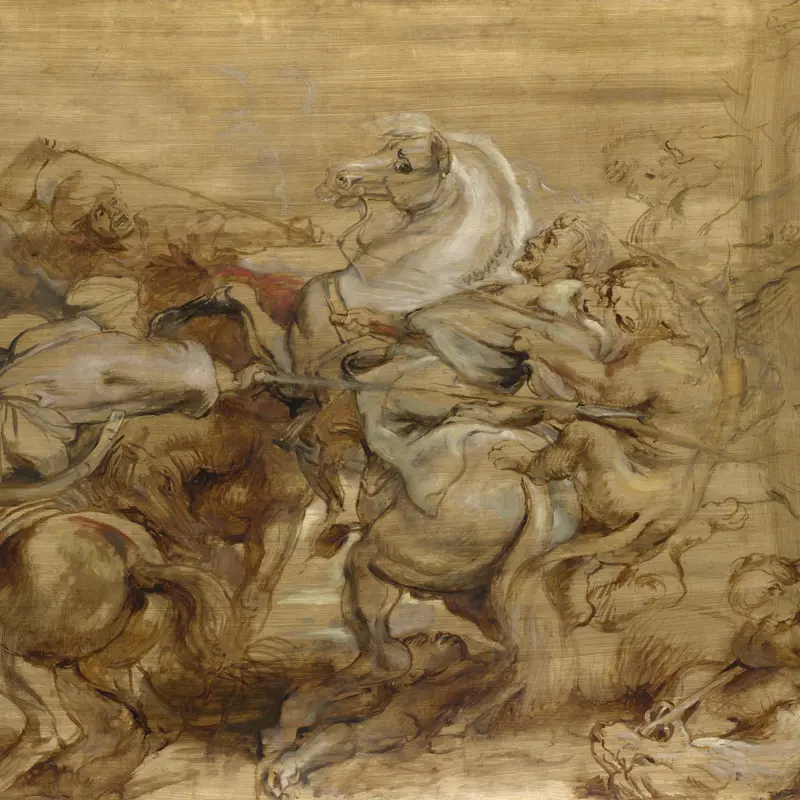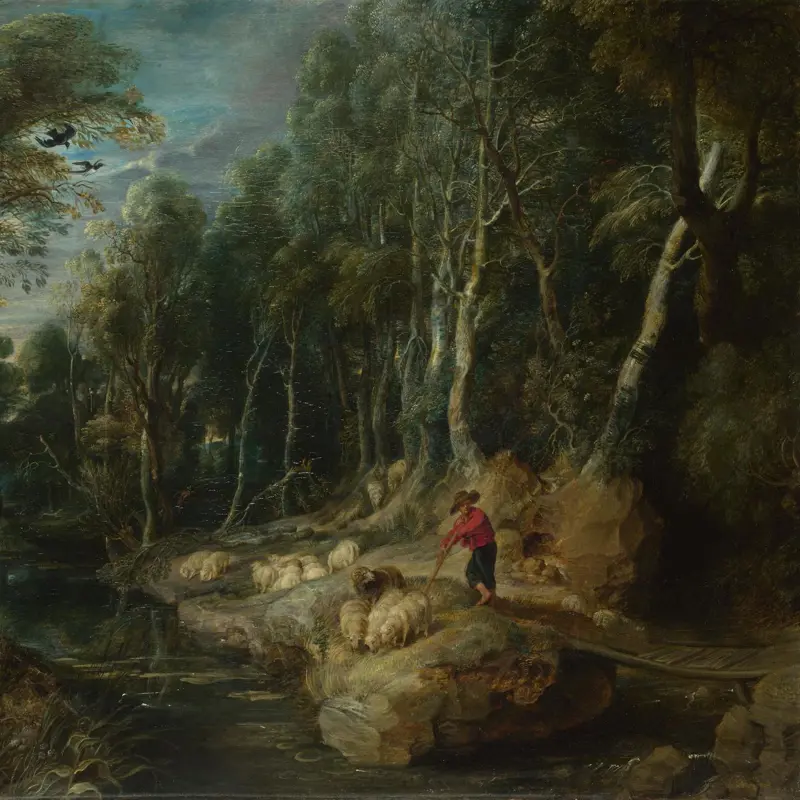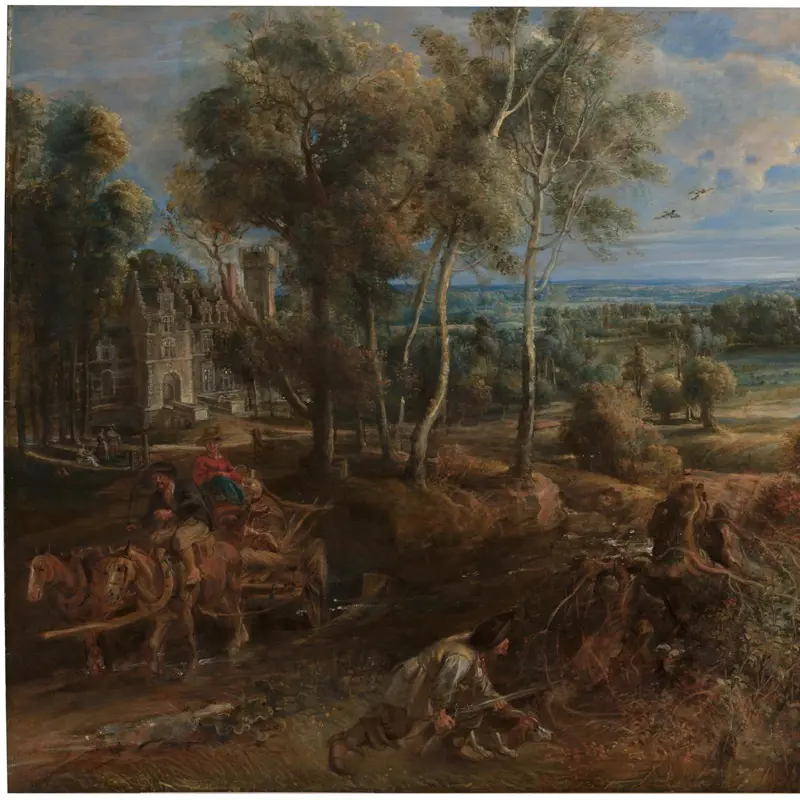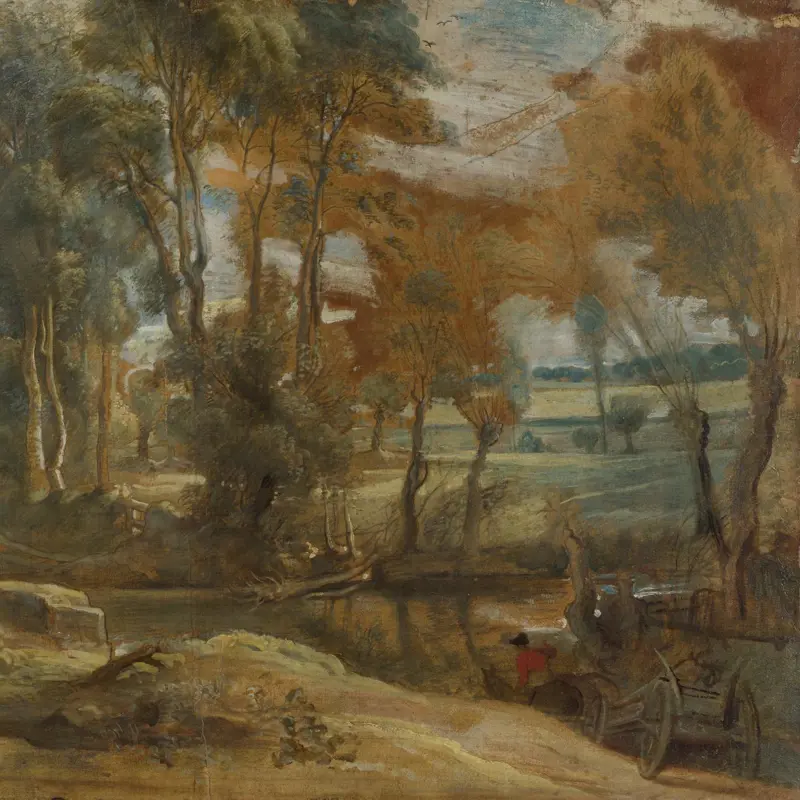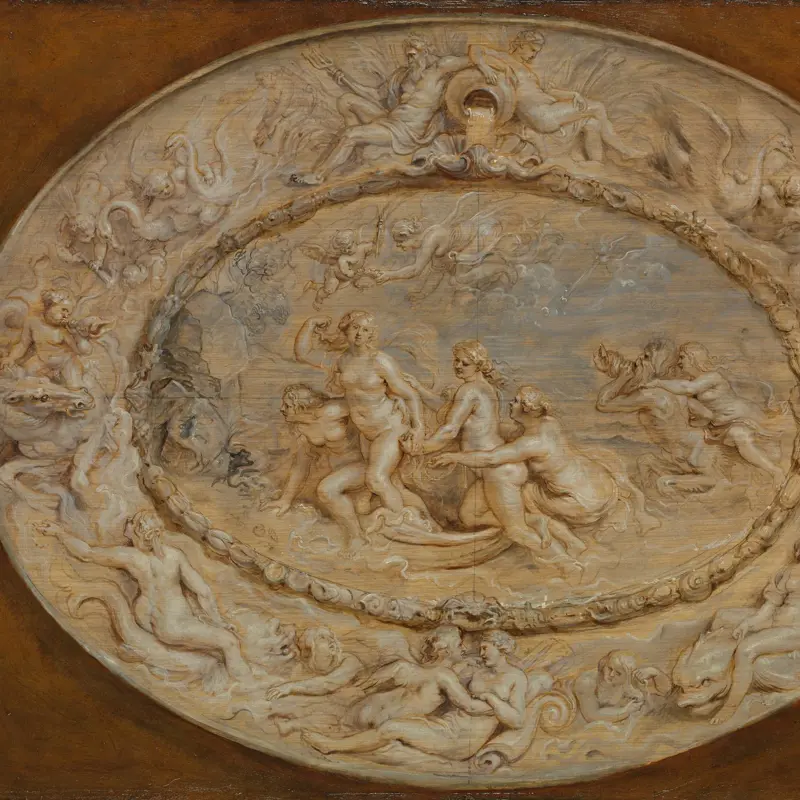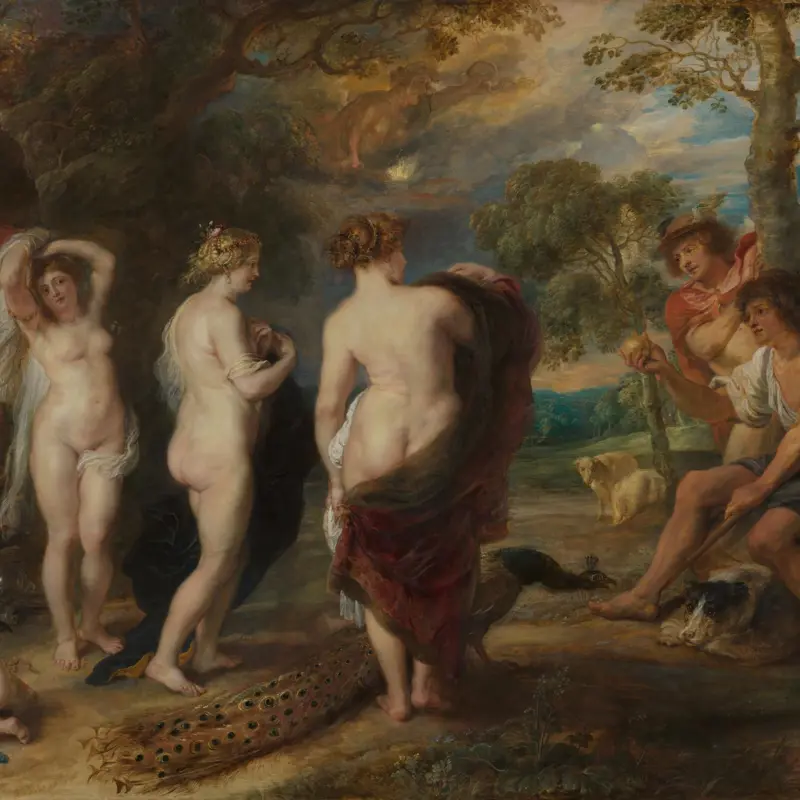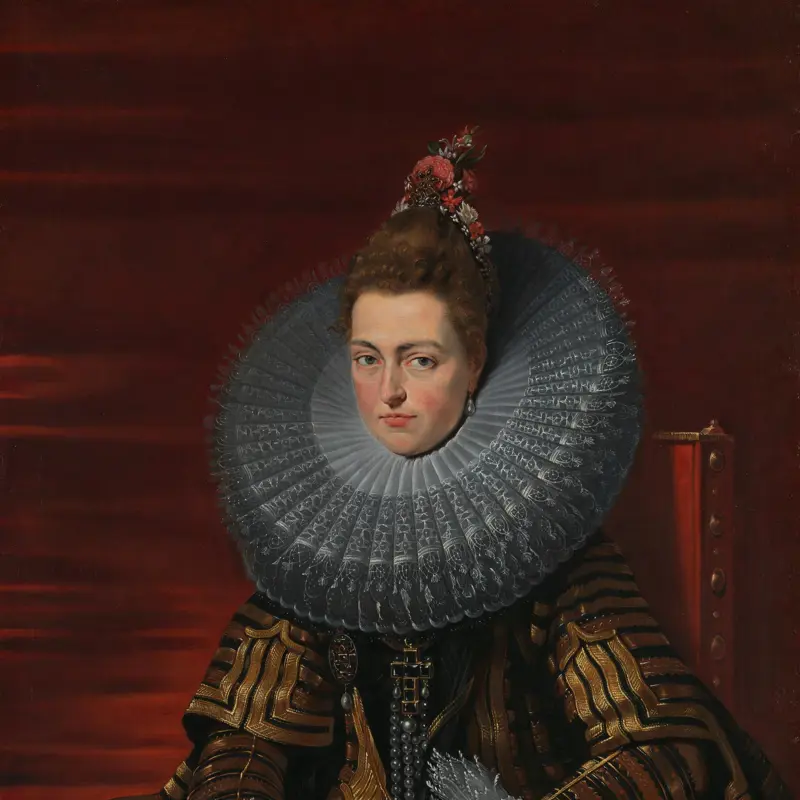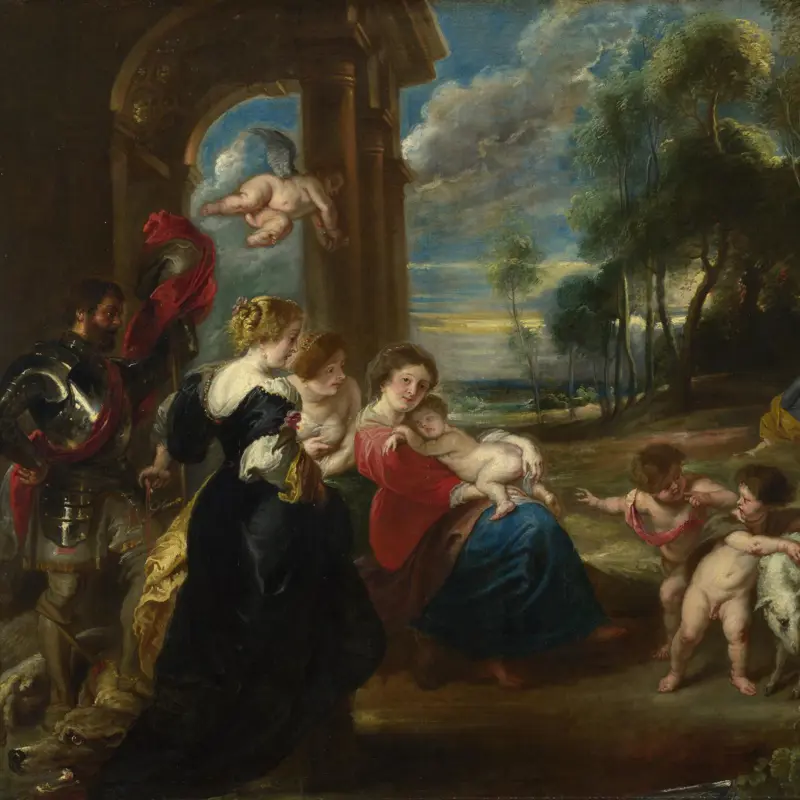Peter Paul Rubens, 'The Watering Place', about 1615-22
About the work
Overview
A young milkmaid with a brass pitcher on her head and a bucket in her hand leads her herd of cattle away for milking. The rising sun reflects in a pool and reaches through the trees to catch the sleek white hides of some of the cows. It’s an idyllic, rustic scene, yet there is energy: people are working and animals moving.
In seventeenth-century Flanders, landscape began to be accepted as a genre of its own instead of as a mere background for narrative paintings or portraits. For Rubens in particular it became a way of celebrating the Flemish countryside he loved. But in England, landscape painting was still neglected, even into the eighteenth century, until artists such as Richard Wilson and Thomas Gainsborough turned their attention to it. The latter saw The Watering Place in London in 1768 and painted a landscape inspired by it in homage to Rubens.
Key facts
Details
- Full title
- Peasants with Cattle by a Stream in a Woody Landscape ('The Watering Place')
- Artist
- Peter Paul Rubens
- Artist dates
- 1577 - 1640
- Date made
- About 1615-22
- Medium and support
- Oil on wood (probably oak)
- Dimensions
- 99.4 × 135 cm
- Acquisition credit
- Bought with a contribution from the Art Fund, 1936
- Inventory number
- NG4815
- Location
- Room 20
- Collection
- Main Collection
- Frame
- 18th-century French Frame
Provenance
Additional information
Text extracted from the ‘Provenance’ section of the catalogue entry in Gregory Martin, ‘National Gallery Catalogues: The Flemish School: circa 1600–circa 1900’, London 1986; for further information, see the full catalogue entry.
Bibliography
-
1756P. Remy, Catalogue raisonné des tableaux, sculptures, tant de marbre que de bronze, desseins et estampes des plus grands maîtres… qui composent le cabinet de feu monsieur le Duc de Tallard, Paris, 22 March 1756 - 13 May 1756
-
1829
J. Smith, A Catalogue Raisonné of the Works of the Most Eminent Dutch, Flemish, and French Painters: In Which is Included a Short Biographical Notice of the Artists, with a Copious Description of Their Principal Pictures […], 9 vols, London 1829-1842
-
1851P.-J. Mariette, Abecedario de P. J. Mariette: Et autres notes inédites de cet amateur sur les arts et les artistes, eds P. de Chennevières and A. de Montaiglon, 6 vols, Paris 1851
-
1873C.G.V. Schneevoogt, Catalogue des estampes gravées d'après P.P. Rubens, avec l'indication des collections où se trouvent les tableaux et les gravures, Haarlem 1873
-
1886M. Rooses, L'œuvre de P. P. Rubens: Histoire et description de ses tableaux et dessins, 5 vols, Antwerp 1886-92
-
1898A. MacKay, Catalogue of the Pictures in Montagu House Belonging to the Duke of Buccleuch, London 1898
-
1909E. Dillon, Rubens, London 1909
-
1926E. Keiser, Die Rubenslandschaft, Rudolstadt 1926
-
1927R. Fry, 'Flemish Art at Burlington House II: The Later Schools', The Burlington Magazine, L/288, 1927, pp. 132-53
-
1928L. Burchard, 'Die neuerworbene Landschaft von Rubens im Kaiser-Friedrich-Museum', Jahrbuch der Preussischen Kunstsammlungen, XLIX/1, 1928, pp. 62-8
-
1931E. Kieser, 'Tizians und Spaniens Einwirkungen auf die späten Landschaften des Rubens', Münchner Jahrbuch der Bildenden Kunst, VIII, 1931, pp. 281-91
-
1936A. Herrmann, Untersuchungen über die Landschaftsgemälde des Peter Paul Rubens, Berlin 1936
-
1936T. Borenius, 'Eine Rubenslandschaft für dee National Gallery', Pantheon, XVII, 1936, pp. 138-9
-
1936N. MacLaren, 'A Rubens Landscape for the National Gallery', The Burlington Magazine, LXVIII/398, 1936, pp. 207-13
-
1937National Gallery, National Gallery and Tate Gallery Directors' Reports, 1936, London 1937
-
1937J.A.G. Raczyński, Die flämische Landschaft vor Rubens, Frankfurt and Main 1937
-
1939A.J.H. Cornette, 'Petrus Paulus Rubens', in S. Leurs (ed.), Geschiedenis van de Vlaamsche Kunst, Antwerp 1939, vol. 2, pp. 647-742
-
1942H.G. Evers, Peter Paul Rubens, Munich 1942
-
1945G. Glück, Die Landschaften von P. P. Rubens, Vienna 1945
-
1963J.T. Hayes, 'Gainsborough and Rubens', Apollo, LXXVIII/18, August 1963, pp. 89-97
-
1963M. Woodall (ed.), The Letters of Thomas Gainsborough, revised edn, London 1963
-
1966G. Martin, 'Two Closely Related Landscapes by Rubens', The Burlington Magazine, CVIII/757, 1966, pp. 180-4
-
1968G. Martin, 'Lucas van Uden's Etchings after Rubens', Apollo, LXXXVII, 1968, pp. 210-1
-
1970G. Martin, The Flemish School, circa 1600-circa 1900, London 1970
-
1973J.T. Hayes, 'A Turning Point in Style: Landscape with Woodcutter', Bulletin Museum of Fine Arts, Houston, IV/2, 1973
-
1980National Gallery, 'Pictures Cleaned and Restored in the Conservation Department of the National Gallery, March 1980 - December 1980', National Gallery Technical Bulletin, V, 1981
-
1981J. Mills and R. White, 'Analyses of Paint Media', National Gallery Technical Bulletin, V, 1981, pp. 66-7
-
1981National Gallery, 'Pictures Cleaned and Restored in the Conservation Department of the National Gallery, January 1981 - December 1981', National Gallery Technical Bulletin, VI, 1982
-
1981D. Gordon, Rubens: The Watering Place and Gainsborough: The Watering Place (exh. cat. The National Gallery, 18 February - 20 April 1981), London 1981
-
1982J.T. Hayes, The Landscape Paintings of Thomas Gainsborough: A Critical Text and Catalogue Raisonné, Ithaca 1982
-
1982W. Adler, Landscapes and Hunting Scenes, Corpus Rubenianum Ludwig Burchard 18, vol. 1, Landscapes, London 1982
-
1982L. Vergara, Rubens and the Poetics of Landscape, New Haven 1982
-
1982C. Brown, A. Reeve and M. Wyld, 'Rubens' "The Watering Place"', National Gallery Technical Bulletin, VI, 1982, pp. 27-39
-
1983C. Brown, 'Rubens' Watering Place: An Examination of His Landscape Technique', Ringling Museum of Art Journal, 1983, pp. 130-49
-
1986Martin, Gregory, National Gallery Catalogues: The Flemish School, circa 1600 - circa 1900, London 1986
-
1988Y. Thiery, Les peintres flamands de paysage au XVIIe siècle: Des précurseurs à Rubens, Brussels 1988
-
1989M. Jaffé, Rubens: Catalogo completo, Milan 1989
-
1991B.B. Fredericksen, 'Documents for the History of Collecting: II. Leonardo and Mantegna in the Buccleuch Collection', The Burlington Magazine, CXXXIII/1055, 1991, pp. 116-8
-
1994T. Nakamura, Rubens and his Workshop: The Flight of Lot and his Family from Sodom, Tokyo 1994
-
1996O. von Simson, Peter Paul Rubens (1577-1640): Humanist, Maler und Diplomat, Mainz 1996
-
1996C. Brown, Rubens's Landscapes (exh. cat. The National Gallery, 16 October 1996 - 19 January 1997), London 1996
-
1997W. Liedtke, '[review] Rubens's Landscapes. London', Burlington Magazine, CXXXIX/1126, January 1997, pp. 54-6
-
1999J. Kirby, 'The Painter's Trade in the Seventeenth Century: Theory and Practice', National Gallery Technical Bulletin, XX, 1999, pp. 5-49
-
2000Egerton, Judy, National Gallery Catalogues: The British Paintings, revised edn, London 2000
-
2000C. Brown, 'The Construction and Development of Rubens's Landscapes: Reflections on the London Exhibition', in H. Vlieghe et al., Concept, Design and Execution in Flemish Painting (1550-1700), Turnhout 2000, pp. 267-278
-
2001
C. Baker and T. Henry, The National Gallery: Complete Illustrated Catalogue, London 2001
-
2001H. Raupp, 'Rubens und das Pathos der Landschaft', in U. Heinen and A. Thieleman (eds.), Rubens Passioni: Kultur der Leidenschaft im Barock, Göttingen 2001, pp. 159-79
-
2004K. Renger, 'Rubens en navolgers', in H. Devisscher (ed.), De uitvinding van het landschap: Van Patinir tot Rubens 1520-1650, Antwerp 2004, pp. 71-6
-
2004H. Raupp, 'Rubens en de pathos van het landschap', in H. Devisscher (ed.), De uitvinding van het landschap: Van Patinir tot Rubens 1520-1650, Antwerp 2004, pp. 77-85
-
2011S. Sloman, Gainsborough’s Landscapes Themes and Variations (exh. cat., Holburne Museum, Bath; Compton Verney, Warwickshire), London 2011
-
2014C. Kleinert, Peter Paul Rubens (1577-1640) and his Landscapes: Ideas on Nature and Art, Turnhout 2014
-
2016N. van Hout, 'Ein so schönes Bild is nie in der Natur gesehen worden. Peter Paul Rubens und die Landschaft', in U. Neidhardt and K. Kruger (eds), Das Paradies auf Erden: Flämische Landschaften von Bruegel bis Rubens, Dresden 2016, pp. 52-7
-
2016S. Bartilla, '[review] Peter Paul Rubens (1577 - 1640) and his Landscapes: Ideas on Nature and Art / Corina Kleinert', Journal für Kunstgeschichte, XX/3, 2016, pp. 238-49
-
2018C.M. Vogtherr, 'Thomas Gainsborough: The Modern Landscape', in C. Martin Vogtherr and K. Hoins (eds), Thomas Gainsborough: The Modern Landscape, Munich 2018, pp. 11-41
-
2020L. Davis, Rubens: The Two Great Landscapes, London 2020
-
2020M. Bellanger and J.-P. Ovion, La collection du Duc d'Hostun-Tallard: Une passionnante chasse aux trésors des tableaux dispersés en 1756, Mercurol 2020
About this record
If you know more about this work or have spotted an error, please contact us. Please note that exhibition histories are listed from 2009 onwards. Bibliographies may not be complete; more comprehensive information is available in the National Gallery Library.


